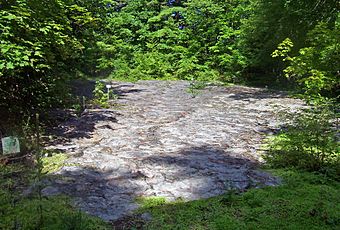Petrified Sea Gardens facts for kids
|
Petrified Sea Gardens
|
|

Cambrian Period undersea grotto
near park entrance, 2008 |
|
| Location | Petrified Sea Gardens Rd., Saratoga Springs, New York |
|---|---|
| Area | 25 acres (10 ha) |
| Built | 1825 |
| NRHP reference No. | 99000631 |
Quick facts for kids Significant dates |
|
| Added to NRHP | January 20, 1999 |
| Designated NHL | January 20, 1999 |
Petrified Sea Gardens is a very special place in Saratoga Springs, New York. It was once known as Ritchie Park. This site protects ancient "sea gardens" made of stromatolites. These are layered rock structures created by tiny living things over millions of years. They are found in a rock layer from the Cambrian Period, which was about 500 million years ago!
This place is important because it was where scientists first truly understood what stromatolites were. For many years, it was a private park open to visitors. Today, it is closed to the public. The Petrified Sea Gardens became a National Natural Landmark in 1967. Later, in 1999, it was named a National Historic Landmark.
What are Petrified Sea Gardens?
The Petrified Sea Gardens site is located at 42 Petrified Sea Gardens Road. It is about 0.5 miles (0.8 km) north of New York State Highway 29. The entire site covers about 25 acres (10 hectares). However, the most interesting rock formations are found in a smaller area of about 1.5 acres (0.6 hectares).
These rock formations are part of a larger geological area called the Hoyt Limestone. You can also see parts of this formation at Lester Park. Lester Park is a public park run by the New York State Museum. It is about 1 mile (1.6 km) north of Petrified Sea Gardens. While stromatolites exist in many places, they are rarely seen in this area. This is because glaciers moved across the land long ago, covering them up.
Understanding Stromatolites
The structures we now call stromatolites were first noticed at this site in 1825. At that time, no one knew exactly what they were. Scientists debated their origin for many years. James Hall, New York's first State Paleontologist, studied them. He figured out that they were made by living things. He even gave them a new scientific name.
Later, a pioneering female paleontologist named Winifred Goldring made a big discovery. She was the first to identify the tiny creatures that created these amazing structures. She said that the stromatolites found here were some of the best examples still existing. Scientists even compared samples from this site to newer stromatolites found in Australia. This helped them understand how these ancient formations grew.
History of the Park
In 1924, a man named Robert F. Ritchie owned the land. He was a stonemason and also loved geology. He decided to open the property as a park. This allowed people to come and see the incredible stromatolites for themselves.
The Petrified Sea Gardens was a special place for many people. It even inspired Stephen Jay Gould when he was a child. He later became one of the most famous paleontologists of the 20th century. For a while, a non-profit group called the Friends of Petrified Sea Gardens ran the site. They kept it open for education until 2006. Today, the Petrified Sea Gardens is closed to the public.



